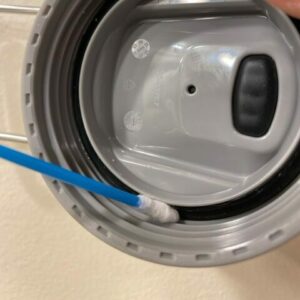As a passionate Stanley water bottle user, I’ve been in the frustrating situation of struggling to open a stubbornly stuck lid. While annoying at the moment, this issue is usually easily resolved with some simple troubleshooting techniques.
In this comprehensive guide, I’ll walk through the common reasons Stanley lids can get stuck and jammed shut. You’ll learn helpful tips for safely opening a seized lid, preventing future sticking, and maximizing the longevity of your Stanley bottle with proper use.
Is it safe to force open a stuck water bottle lid?
While extremely tempting when struggling with a stubborn lid, avoid aggressively forcing it open at all costs. Not only can this permanently damage the bottle by cracking plastic components, but you also risk physical harm like hand cuts from slipping. For personal safety and to prevent bottle damage, finesse is key.
How to Open a Stuck Lid on Your Stanley Water Bottle
When initially trying to loosen a stuck lid, follow these safe techniques:
- First, ensure the lid is fully rotated counter-clockwise in the open direction. Test gently to identify the initial sticking point.
- Run the sealed bottle under warm water. The mild heat expands the air pocket inside, releasing built-up pressure on the lid.
- Firmly grip the bottle body only to stabilize. Wrap the lid with a towel or use a Jar and Bottle Opener for grip. Rotate in small back-and-forth motions, applying gradual pressure to break the seal.
- Once moving, finish unscrewing slowly without forcing. Stop if excessive tightness remains.
- Contact Stanley customer service if it is still unopenable after warm water attempts. They can advise on warranty replacements if needed.
Avoid previously suggested home remedies like pliers or vise grips; these damage rather than help!

Here are some common household items that provide extra grip and leverage for freeing stuck water bottle caps:
GOOD: Thin Towel: Wraps around the cap to protect the finish
BETTER: Rubber Jar Opener: Extra grip for easier opening
BEST: Strap Wrench Opener: Protects cap finish and provides leverage for any size cap or lid
These simple yet handy items give you a big assist when attempting to open an inexplicably stuck Contigo lid away from home.
While adjusting your regular usage and cleaning habits prevents most stuck lids in the future, having the right tools on hand lets you quickly troubleshoot surprise lid sticking when on the go.
What are some common reasons for a stuck lid on a water bottle?
The main culprits behind the stubbornly stuck lids on Stanley bottles are:
| Cause | Description |
|---|---|
| Over-tightening | Excessive force leads to stripped threads and wedging. The rubber gasket gets over-compressed. |
| Temperature Change | External heating or cooling causes pressure changes. Lids can temporarily “vacuum seal.” |
| Dried-on Liquid Residue | Sugary, fatty, or sticky dried beverage residue creates a “glue” effect. |
| Cross-Threading | Not aligning threads properly can wedge the lid at an angle. |
| New Seal/Gasket | Fresh rubber has higher friction before wearing in with use. |
| Dents/Damage | External bottle damage misaligns the neck and internal threading. |
With care and preventative habits, stuck lids are less likely and easier to resolve when they do happen.
Is It Common for Stanley Lids to Get Stuck?
Occasional minor sticking of Stanley water bottle lids is reasonably common, especially if the seal or gasket is new. The popularity of these bottles means it’s a frequent customer complaint. Thankfully, there are some simple explanations for this inconvenience and ways to avoid it becoming a recurring headache.
Can extreme temperatures cause a water bottle lid to get stuck?
Yes, external temperature shifts can absolutely contribute to temporary stuck lids on Stanley bottles.
- Heating the bottle with hot water or direct sun exposure increases internal air pressure, forcing the lid tightly against the mouth.
- Likewise, cooling down a bottle with ice water or in the freezer decreases internal pressure. This creates a strong vacuum suction, making the lid difficult to break loose.
- Try returning the bottle to room temperature before opening it to equalize interior pressure and relieve temporary sticking from temperature extremes.
Is It a Seal Issue? Understanding Lid Sticking
Gasket and seal conditions can also cause lids to stick.
- Worn-out gaskets with reduced elasticity can develop static friction against the mouth rim.
- Foreign debris embedded in the gasket creates friction and interference.
- Chlorine degradation, or UV damage, makes rubber gaskets brittle and sticky.
- Quality control defects lead to abnormal rubber texturing or gasket tolerances.
If sticking persists after cleaning residue and troubleshooting, gasket replacement may be required. Checking for damage and replacing it annually helps prevent issues.
How can I prevent my water bottle lid from getting stuck in the first place?
Stuck lids are annoying, but you can minimize them with these tips:
- Tighten just until initial resistance; avoid forcing it further to prevent over-compression.
- Always fully loosen it after use; don’t leave it partially threaded.
- Clean thoroughly after sugary, oily, or creamy beverages. Avoid drying the residue.
- Store bottles with lids loosened to maintain gasket and seal pliability.
- Replace damaged lids and inspect or replace gaskets annually.
- Allow it to reach room temperature before opening hot or cold bottles.
Proactive habits maximize enjoyment and minimize frustration! But how tight should you actually be?
How Tight Should I Close My Stanley Bottle Lid?
Finding the ideal tightening sweet spot takes practice.
- Tighten firmly until initial resistance is felt, but avoid forced over-tightening.
- Only rotate clockwise until the lid stops naturally; don’t muscle past this point.
- The rubber gasket surface should appear uniform, not bunched, pinched, or warped.
- Tightness should evenly compress the gasket to create an impervious seal without excessive force.
- Adjust your technique over time based on performance; if sticking occurs, tighten slightly less firmly next time.
Getting a feel for ideal torque will become second nature with use. But what about using lubricants to help open a stuck lid?
Can Lubricants Be Used to Loosen a Jammed Lid?
Lubricating a stuck lid may seem like a solution, but I don’t recommend using any lubrication on water bottle lids, seals, or gaskets. If you do, exercise great caution.
Although applying a thin layer of food-grade lubricant to the threads or seals of your water bottle may make it easier to remove the lid, it can also encourage overtightening because the lubricant can make the lid tighten more easily.
Start by applying a (very thin) coat of a food-grade, non-petroleum-based lubricant to the O-ring with a cotton swab or the tip of a twisted paper towel. Then remove any extra lubricant with a clean cotton swab or paper towel, leaving only a trace of lubricant on the O ring. Petroleum-based lubricants like gasoline will deteriorate the rubber O-ring over time, so I highly recommend that you stick to a silicone-based lubricant.

- Avoid petroleum-based oils or greases that degrade rubber; they can leak chemicals into the contents.
- Silicone-based lubricants are much safer options for food-grade bottle use.
- Apply only externally around the lid rim; never inside touching contents.
- Use the smallest amount possible—a thin film to assist friction, not an excess.
- Try a non-oily lubricant like vegetable or coconut oil if available.
Lubrication reduces friction but won’t fix underlying issues like worn gaskets. Use only as needed until replacement seals restore smooth function.
Alternative methods for opening a stuck water bottle lid?
In addition to heat expansion and lubrication, some other safe options for freeing stuck lids include:
- Firm, repeated impacts against a padded surface The vibrations can jostle things loose.
- Get some help from a friend, one person holds the bottle while the other turns the cap
- Placing a rubber jar opening pad or a belt wrench around the lid edges improves grip and traction when turning.
With patience and care, you can safely get your Stanley bottle functioning again. But if you can’t fix your sticking Stanley bottle lid, contact Stanley’s support to explore replacement options. Adhering to preventative best practices maximizes trouble-free enjoyment of your Stanley for years on end.
I hope these troubleshooting tips empower you to easily tackle any future stuck lids. Let me know if any other questions arise!

About Me
I’m Paul Burkhardt, an expert in water and water treatment since 2006 with in-depth experience not only in treating water but also in helping to provide people with healthier, high-quality drinking water.
I’ve helped thousands of people with their drinking water questions, including what kind of water bottle might be best for them and their lifestyle.
If you’d like more information about me, please check out the links below or read more here:

